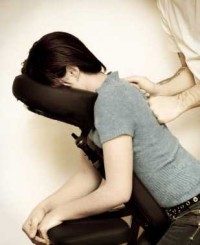 You may have seen them in airports, at the mall, a health fair perhaps. A person kneeling on an ergonomically correct chair of sorts, their face partially concealed by a face rest, and a therapist behind them in a lunge position kneading, digging in their thumbs, or lightly pounding on the client’s back. It may have looked a little strange, or even painful at times as you see the therapist use their elbow to get at a particularly troublesome spot. Chances are, the client in that strange looking chair is smiling and relaxed, and reaping some long lasting benefits from a brief massage session.
You may have seen them in airports, at the mall, a health fair perhaps. A person kneeling on an ergonomically correct chair of sorts, their face partially concealed by a face rest, and a therapist behind them in a lunge position kneading, digging in their thumbs, or lightly pounding on the client’s back. It may have looked a little strange, or even painful at times as you see the therapist use their elbow to get at a particularly troublesome spot. Chances are, the client in that strange looking chair is smiling and relaxed, and reaping some long lasting benefits from a brief massage session.
Seated massage is gaining popularity in public places such as airports because people are realizing its benefits and convenience. Seated massage is done in a specially designed chair that evenly distributes the client’s weight, and is quite comfortable. Primarily utilizing Swedish and trigger point or acupressure techniques, the therapist performs all massage techniques with the client fully clothed and uses no oil. The work is mostly done on the neck and back, but many therapists will also incorporate work on the arms and hands, the legs, and the scalp and face. Because it is a short session, and limited to specific areas, a seated session can be quite specific and a therapist may quickly hone in on a troublesome area. This can have the effect of being instantly relieving, if a client’s back or neck is in pain, as opposed to a longer session on a table in which the whole body is being worked. I have personally had some very effective seated massage, and can attest that a good ten-minute session from a skilled therapist will give longer lasting relief than an hour session from a mediocre therapist.
Seated massage has similar benefits to a traditional table massage. It invigorates the circulation, relieves pain, temporarily lowers blood pressure (regular massage can have a more permanent effect on hypertension), increases range of motion, strengthens the immune system, and heightens a sense of well being and energy.
Studies conducted at the Touch Research Institute in Florida revealed that seated massage yields quick benefits. Short, seated sessions resulted in heightened alertness, and better performance on math tests given shortly after. At the end of the five-week period, subjects reported a decrease in job stress and elevated moods. It is important to note that in the 1993 World Labor Report, job stresses were blamed for costing the U.S. economy $200 billion each year “through diminished productivity, compensation claims, absenteeism, health insurance, and direct medical expenses.” (International Labor Organization) Many companies nationwide are utilizing massage therapy breaks to help compensate for a stressful and hectic work pace and lessen the incidents of work related injuries such as carpal tunnel syndrome
For those intimidated by the thought of a traditional massage, seated massage may be a good place to break the ice, as the client is fully clothed and in the presence of other people. It is also an inexpensive way to get acquainted with the benefits of massage.
